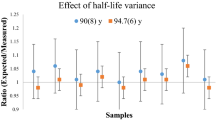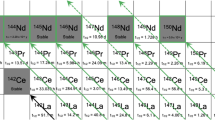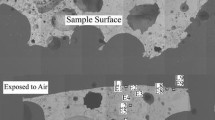Abstract
135Cs/137Cs measurements were performed on a set of debris samples from the first nuclear test, Trinity. Debris from several locations around ground zero of the event were purified and analyzed for 135Cs/137Cs by thermal ionization mass spectrometry (TIMS). The Cs-isotopic measurements presented here are the first high precision TIMS 135Cs/137Cs measurements of trinitite from variable locations and cooling histories relative to ground zero. Our measurements show a large fractionation from the predicted fission yields, all with a relative enrichment in 137Cs. 135Cs/137Cs ratios indicate that condensation times varied between different debris forms, however they are not consistent with an unfractionated decay to Cs from independent fission products. Variations in 135Cs/137Cs ratios are observed with relative distance from ground zero as well as 135Cs/137Cs heterogeneities between different trinitite lithologies within a single sample.





Similar content being viewed by others
References
Lee T et al (1993) 1st Detection of fallout Cs-135 and potential applications of Cs-137/Cs-135 ratios. Geochim Cosmochim Acta 57(14):3493–3497
Singh B, Rodionov AA, Khazov YL (2008) Nuclear data sheets for A=135. Nucl Data Sheets 109(3):517–698
Barker JA et al (1974) Interatomic potentials for krypton and xenon. J Chem Phys 61(8):3081–3089
Strritzky E (1950) Thermal effects of atomic bomb explosions on soils at trinity and Eniwetok, in LA-1126. 1950, Los Alamos National Laboratory
Day JMD et al (2017) Evaporative fractionation of zinc during the first nuclear detonation. Sci Adv 3(2):e1602668
Freiling EC, Kay MA (1966) Radionuclide fractionation in air-burst debris. Nature 209(5020):236
Snyder DC et al (2012) Radioactive cesium isotope ratios as a tool for determining dispersal and re-dispersal mechanisms downwind from the Nevada Nuclear Security Site. J Environ Radioact 110:46–52
Khan FA (2020) Estimating the photo-fission yield of the Trinity Test. Sci Rep 10(1):4200
Selby HD et al (2021) A new yield assessment for the trinity nuclear test, 75 years later. Nucl Technol 207:S321–S325
Zok D et al (2021) Determination of characteristic vs anomalous Cs-135/Cs-137 isotopic ratios in radioactively contaminated environmental samples. Environ Sci Technol 55(8):4984–4991
Eby GN et al (2015) Trinitite redux: mineralogy and petrology. Am Miner 100(2–3):427–441
Ross CS (1948) Optical properties of glass from alamogordo. New-Mexico Am Mineral 33(5–6):360–362
Melosh HJ, Vickery AM (1991) Melt droplet formation in energetic impact events. Nature 350(6318):494–497
Adams CE, Farlow NH, Schell WR (1960) The compositions, structures and origins of radioactive fall-out particles. Geochim Cosmochim Acta 18(1–2):42–000
Belloni F et al (2011) Investigating incorporation and distribution of radionuclides in trinitite. J Environ Radioact 102(9):852–862
Bonamici CE et al (2017) A geochemical approach to constraining the formation of glassy fallout debris from nuclear tests. Contrib Mineral Petrol 172(1):1–23
Cassata WS et al (2014) When the dust settles: stable xenon isotope constraints on the formation of nuclear fallout. J Environ Radioact 137:88–95
Lewis LA et al (2015) Spatially-resolved analyses of aerodynamic fallout from a uranium-fueled nuclear test. J Environ Radioact 148:183–195
Smit JV, Robb W, Jacobs JJ (1959) Cation exchange on ammonium molybdophosphate. 1. The alkali metals. J Inorg Nucl Chem 12(1–2):104–112
Coetzee CJ, Rohwer EFCH (1970) Cation exchange studies on ammonium-12-molybdophosphate. J Inorg Nucl Chem 32(5):1711–2000
Snow MS et al (2015) Method for ultra-trace cesium isotope ratio measurements from environmental samples using thermal ionization mass spectrometry. Int J Mass Spectrom 381:17–24
Bu WT et al (2019) Ultra-trace determination of the Cs-135/Cs-137 isotopic ratio by thermal ionization mass spectrometry with application to Fukushima marine sediment samples. J Anal At Spectrom 34(2):301–309
Zheng J et al (2016) Triple-quadrupole inductively coupled plasma-mass spectrometry with a high-efficiency sample introduction system for ultratrace determination of Cs-135 and Cs-137 in environmental samples at femtogram levels. Anal Chem 88(17):8772–8779
Dunne JA, Richards DA, Chen HW (2017) Procedures for precise measurements of Cs-135/Cs-137 atom ratios in environmental samples at extreme dynamic ranges and ultra-trace levels by thermal ionization mass spectrometry. Talanta 174:347–356
Russell BC, Croudace IW, Warwick PE (2015) Determination of Cs-135 and Cs-137 in environmental samples: a review. Anal Chim Acta 890:7–20
Bu WT et al (2016) Mass spectrometry for the determination of fission products Cs-135, Cs-137 and Sr-90: a review of methodology and applications. Spectrochimica Acta Part B-Atomic Spectr 119:65–75
Reinhard A et al (2021) Isotopic analysis of sub-nanogram neodymium loads using new ATONA (TM) amplifiers. Rapid Commun Mass Spectr. https://doi.org/10.1002/rcm.9032
Szymanowski D, Schoene B (2020) U-Pb ID-TIMS geochronology using ATONA amplifiers. J Anal At Spectrom 35(6):1207–1216
Agency IAE (2009) Reference sheet for certified reference material IAEA-330 radionuclides in spinach. Internation atomic energy agency: https://nucleus.iaea.org/sites/ReferenceMaterials/Shared%20Documents/ReferenceMaterials/Radionuclides/IAEA-330/rs_iaea_330.pdf. p 1–4
Wilson WB, STC, England TR, Hayes AC (2008) A manual for CINDER’90 Version 07.04 codes and data. Los Alamos national laboratory
Werner CJ (2017) MCNP Users Manual-Code Version 6.2. 2017
Wilson WB et al (1997) CINDER’90 code for transmutation calculations. Int Conf Nucl Data Sci Technol 59:1454–1457
Parekh PP et al (2006) Radioactivity in Trinitite six decades later. J Environ Radioact 85(1):103–120
Bellucci JJ et al (2014) A detailed geochemical investigation of post-nuclear detonation trinitite glass at high spatial resolution: delineating anthropogenic vs natural components. Chem Geol 365:69–86
Fuge R (1990) The role of volatility in the distribution of iodine in the secondary environment. Appl Geochem 5(3):357–360
Hu QH, Weng JQ, Wang JS (2010) Sources of anthropogenic radionuclides in the environment: a review. J Environ Radioact 101(6):426–437
Fujii T et al (2004) Volatility of tellurium and various fission products in heated nitric acid solutions. J Radioanal Nucl Chem 262(3):551–554
Mcdonough WF, Sun SS (1995) The composition of the earth. Chem Geol 120(3–4):223–253
Mills NM, Agee CB, Draper DS (2007) Metal-silicate partitioning of cesium: Implications for core formation. Geochim Cosmochim Acta 71(16):4066–4081
Jochum KP, Hofmann AW, Seufert HM (1993) Tin in mantle-derived rocks - constraints on earth evolution. Geochim Cosmochim Acta 57(15):3585–3595
Cook CS et al (1960) Fractionation of nuclear weapon debris. Nature 187(4743):1100–1101
Edvarson K, Low K, Sisefsky J (1959) Fractionation phenomena in nuclear weapons debris. Nature 184(4701):1771–1774
Hanson SK et al (2016) Measurements of extinct fission products in nuclear bomb debris: determination of the yield of the Trinity nuclear test 70 y later. Proc Natl Acad Sci USA 113(29):8104–8108
Delmore JE et al (2011) Cesium isotope ratios as indicators of nuclear power plant operations. J Environ Radioact 102(11):1008–1011
Kim JS et al (2015) Analysis of high burnup pressurized water reactor fuel using uranium, plutonium, neodymium, and cesium isotope correlations with burnup. Nucl Eng Technol 47(7):924–933
Snow MS, Snyder DC, Delmore JE (2016) Fukushima Daiichi reactor source term attribution using cesium isotope ratios from contaminated environmental samples. Rapid Commun Mass Spectrom 30(4):523–532
Acknowledgements
This work was graciously supported by the Laboratory Directed Research and Development program of Los Alamos National Laboratory under project 20210215DR. We would like to thank Hakim Boukhalfa and Doug Ware for their assistance in acquiring and photographing debris samples. We would also like to thank Reg Rocha for his guidance concerning data interpretation.
Author information
Authors and Affiliations
Corresponding author
Ethics declarations
Conflict of interest
The authors have no relevant financial or non-financial interests to disclose.
Additional information
Publisher's Note
Springer Nature remains neutral with regard to jurisdictional claims in published maps and institutional affiliations.
Supplementary Information
Below is the link to the electronic supplementary material.
Rights and permissions
Springer Nature or its licensor (e.g. a society or other partner) holds exclusive rights to this article under a publishing agreement with the author(s) or other rightsholder(s); author self-archiving of the accepted manuscript version of this article is solely governed by the terms of such publishing agreement and applicable law.
About this article
Cite this article
Boggs, M.A., Reinhard, A.A., Inglis, J. et al. Measurements of 135Cs/137Cs in debris from the Trinity nuclear test. J Radioanal Nucl Chem 332, 4157–4165 (2023). https://doi.org/10.1007/s10967-023-09096-9
Received:
Accepted:
Published:
Issue Date:
DOI: https://doi.org/10.1007/s10967-023-09096-9




